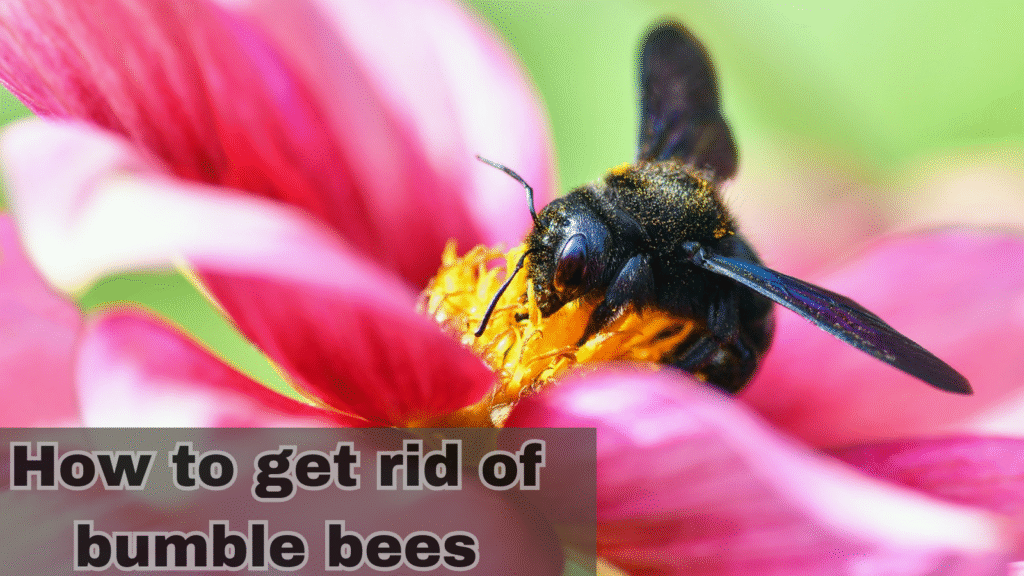How to Get Rid of Bumble Bees: Your Homeowner’s Ethical Guide
Picture this: it’s a warm Saturday afternoon, and you’re about to enjoy your backyard oasis. But as you approach your shed, you hear it—a persistent, low-pitched buzz. A fuzzy, black-and-yellow insect is hovering near a small hole in the ground. Your first thought might be panic, but your second should be a crucial question: Is this a friend or a foe? If you’re wondering how to get rid of bumble bees, the most important step isn’t reaching for a spray; it’s reaching for knowledge.
This isn’t just another generic list of pest control tactics. This guide will walk you through a thoughtful, ethical approach to dealing with these important pollinators. We’ll explore why you might want to learn how to get rid of bumble bees, when you absolutely shouldn’t, and the safest methods for both you and the bees. The goal isn’t annihilation; it’s peaceful coexistence, or when necessary, safe and humane relocation.
First, Know Your “Enemy”: Bumble Bee vs. Honey Bee vs. Wasp
Before you take any action, correct identification is critical. Misidentifying a bee can lead to unnecessary stings or the destruction of a beneficial insect population. Many people use “bee” as a catch-all term, but the strategy for how to get rid of bumble bees safely is very different from dealing with wasps. Understanding how to get rid of bumble bees without harming the environment starts with knowing exactly what you’re dealing with.
| Feature | Bumble Bee | Honey Bee | Wasp (e.g., Yellowjacket) |
| Body Shape | Large, robust, and very fuzzy | Slender, with a more streamlined body | Smooth, slender, with a narrow “waist” |
| Nest Location | Often in abandoned rodent burrows, under decks, in compost piles | Hives in hollow trees, walls, or man-made apiaries | Papery nests in eaves, underground, or shrubs |
| Temperament | Docile and unlikely to sting unless provoked | Defensive of their hive but generally non-aggressive | Aggressive, especially near their nest; attracted to food |
| Sting Capability | Can sting multiple times | Stings once, then dies | Can sting multiple times |
Source: The Xerces Society for Invertebrate Conservation
As you can see, bumble bees are the gentle giants of the bee world. They are not seeking conflict. Understanding this is the foundation of any plan to how to get rid of bumble bees responsibly.
The “Why”: Valid Reasons to Encourage Bumble Bees to Leave
While they are beneficial, there are legitimate safety concerns that might lead you to figure out how to get rid of bumble bees.
- Severe Allergies: If you or a family member has a life-threatening allergy to bee stings, proximity to a nest is a serious health risk.
- High-Traffic Areas: A nest directly next to a doorway, playground, or pet area creates a high risk of accidental encounters and defensive stings.
- Structural Concerns: While rare, if bees are nesting inside a wall or structural void, the subsequent moisture and honeycomb can cause damage over time.
If your situation doesn’t fall into these categories, consider tolerance. Bumble bees are phenomenal pollinators, responsible for pollinating crops like tomatoes, peppers, and berries through a unique process called “buzz pollination.” Their presence can mean a more beautiful flower garden and a more productive vegetable patch. And just as people often ask How Long Does It Take to Tint when planning improvements, it’s worth taking time to understand the natural benefits bumble bees provide before deciding to remove them.
Step-by-Step: How to Get Rid of Bumble Bees Humanely and Safely

If relocation is necessary, your primary goal is to do it without harming these vital creatures. The following methods focus on encouragement, not extermination.
Step 1: Prevention is the Best Medicine
The easiest way to get rid of bumble bees is to make your property uninvited in the first place. Queen bumble bees look for nesting sites in early spring.
- Seal Entry Points: Carefully fill in abandoned rodent burrows and holes in the ground.
- Cover Compost Bins: Keep compost piles covered or use enclosed bins.
- Secure Vents and Openings: Use fine mesh wire to cover vents and openings under decks or sheds.
Step 2: Encourage Natural Relocation (The Non-Lethal Approach)
If a nest is already established, you can often persuade them to leave on their own.
- Create Gentle Disturbances: Bumble bees prefer quiet, undisturbed locations. Simply increasing activity near the nest—like gently mowing the grass nearby more frequently—can encourage them to find a quieter home.
- Use Scents They Dislike: Peppermint oil, cinnamon, and citrus oils are natural bee deterrents. Soak cotton balls in these essential oils and place them near, not in, the nest entrance. Reapply after rain. This makes the area less appealing without harming the bees.
Step 3: The After-Dark Relocation Method
If the nest is in an absolutely critical area and must be moved, this is the safest method. Perform this task at night when all the bees are inside the nest and are less active.
What You’ll Need:
- A large glass bowl or clear plastic container
- A flat, sturdy piece of cardboard or a trowel
- Heavy gloves and long sleeves
The Process:
- Approach Calmly: Move slowly and avoid vibrating the ground.
- Cover the Entrance: Gently but quickly place the bowl over the nest’s entrance hole, sealing it completely.
- Wait and Relocate: The bees will be trapped but safe. The next evening, slide the cardboard under the bowl to fully contain them. You can then carry the entire container to a new location far from your home and release them. Just as people often ask How Long Do You Have to Wear certain protective gear or devices for safety, handling bees with patience and care ensures both effectiveness and harm-free relocation.
This method requires care but is a very effective and humane way to get rid of bumble bees.
What NOT to Do: Common Mistakes to Avoid
In your quest to learn how to get rid of bumble bees, avoid these dangerous and counterproductive actions.
- Do Not Use Pesticide Sprays: This is ineffective for ground nests, harmful to the environment, and will likely provoke the bees, leading to stings.
- Do Not Pour Water or Gasoline into the Nest: This is cruel, environmentally disastrous, and extremely dangerous.
- Do Not Block the Entrance During the Day: You will trap foraging bees outside, who will become agitated, and you won’t solve the root problem. Just like learning How to Get Your pH Balance back to normal requires understanding the underlying cause, addressing a bee issue effectively means focusing on the source, not just the symptoms.
When to Call a Professional Wildlife Remover
Sometimes, the safest and smartest answer to how to get rid of bumble bees is to call for backup.
Call a pro if:
- The nest is inside a wall, attic, or other inaccessible void.
- You are allergic to bee stings.
- You’ve tried gentle methods and the nest is still in a high-risk location.
- You are uncomfortable or unsure about handling the situation yourself.
Look for a bee removal specialist or wildlife control operator who practices live removal. Ask about their methods upfront to ensure they align with your goal of protecting these important pollinators. The Pollinator Partnership is a great resource for finding pollinator-friendly practices and professionals.
A Final Word: Coexistence is the Goal
Learning how to get rid of bumble bees is less about eradication and more about intelligent, respectful management of our shared environment. These fuzzy insects are not out to get us; they are simply trying to survive and raise their young, much like we are.
Before you take action, pause. Assess the real risk. Often, the best solution is to give them space and let them complete their short life cycle, which typically ends in late summer. By choosing humane methods, you’re not just solving a temporary problem—you’re contributing to the health of your local ecosystem.
Read More Like This: Erome Asian
Frequently Asked Questions (FAQs)
What is the fastest way to get rid of bumble bees?
While speed is often a priority, the fastest method isn’t always the safest or most ethical. The quickest humane method is the after-dark relocation technique described above. However, the absolute fastest method—using pesticide sprays—is not recommended. It’s hazardous, environmentally damaging, and often provokes the bees, increasing the risk of stings. When learning how to get rid of bumble bees, prioritizing safety for yourself and the bees is more important than speed.
Are bumble bee stings dangerous?
For the vast majority of people, a bumble bee sting is temporarily painful but not dangerous. The area may become red, swollen, and itchy for a day or two. However, as with any insect sting, some individuals can have a severe allergic reaction (anaphylaxis). If you know you are allergic, or if someone experiences difficulty breathing, swelling of the throat, or dizziness after a sting, seek emergency medical attention immediately. This risk is the primary reason someone might need to learn how to get rid of bumble bees near their home.
Will bumble bees damage my house?
Unlike other pests, bumble bees are very unlikely to cause structural damage. They do not eat wood like carpenter bees or build large, destructive hives. The only potential concern for a homeowner is if a colony establishes itself inside a wall void. Over time, the old wax and pollen from an abandoned nest could attract other pests. This is a rare scenario, but it is a valid reason to figure out how to get rid of bumble bees from within a structure.
Is it illegal to kill bumble bees?
In many regions, certain bumble bee species are protected or their status is under review due to population declines. While there may not be a specific law against killing a single bee, the use of pesticides is heavily regulated and applying them incorrectly can violate local ordinances. The ethical and legal safest path is always to use humane, non-lethal methods. We strongly recommend focusing on relocation rather than extermination when you need to know how to get rid of bumble bees.
How long do bumble bees stay in one place?
Understanding their life cycle is key to tolerance. A bumble bee colony is an annual affair. The queen starts a new nest each spring, the colony grows through the summer, and by late summer or early fall, the entire colony naturally dies off—except for new queens who leave to hibernate. In most cases, a nest is only active for 3-4 months. If the nest is in a low-traffic area, the simplest and most eco-friendly solution for how to get rid of bumble bees is often to just wait it out.

